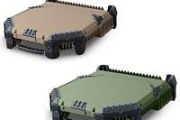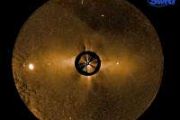
Copernical Team
New satellite data techniques reveal coastal sea-level rise

For the hundreds of millions of people living in coastal regions around the world, rising seas driven by climate change pose a direct threat. In order for authorities to plan appropriate protection strategies, accurate information on sea-level rise close to the coast is imperative. For various reasons, these measurements are difficult to get from satellites. However, new ESA-funded research demonstrates how a specific way of processing satellite altimetry data now makes it possible to determine sea-level change in coastal areas with millimetre per year accuracy, and even if the sea is covered by ice.
International Space Station update: June in orbit

Just over two months into his Alpha mission, ESA astronaut Thomas Pesquet has performed three spacewalks and supported numerous European and international experiments in microgravity. As the International Space Station crew embark on another busy month in low-Earth orbit, we reflect on some highlights from June.
Tiangong: astronauts are working on China's new space station - here's what to expect
 Three astronauts on China's new space station have just performed the country's first space walk and are busy configuring the module for future crews. Named Tiangong ("heavenly palace"), the station is the Chinese National Space Agency (CNSA)'s signature project to develop China's ambitions for having humans in orbit around Earth for a long amount of time.
In planning since the late 1990s,
Three astronauts on China's new space station have just performed the country's first space walk and are busy configuring the module for future crews. Named Tiangong ("heavenly palace"), the station is the Chinese National Space Agency (CNSA)'s signature project to develop China's ambitions for having humans in orbit around Earth for a long amount of time.
In planning since the late 1990s, Pathfinder satellite paves way for constellation of tropical-storm observers
 The 2020 Atlantic hurricane season was one of the most brutal on record, producing an unprecedented 30 named storms. What's more, a record-tying 10 of those storms were characterized as rapidly intensifying - some throttling up by 100 miles per hour in under two days.
To provide a more consistent watch over Earth's tropical belt where these storms form, NASA has launched a test satellite,
The 2020 Atlantic hurricane season was one of the most brutal on record, producing an unprecedented 30 named storms. What's more, a record-tying 10 of those storms were characterized as rapidly intensifying - some throttling up by 100 miles per hour in under two days.
To provide a more consistent watch over Earth's tropical belt where these storms form, NASA has launched a test satellite, Kepler telescope glimpses population of free-floating planets
 Tantalising evidence has been uncovered for a mysterious population of "free-floating" planets, planets that may be alone in deep space, unbound to any host star. The results include four new discoveries that are consistent with planets of similar masses to Earth, published in Monthly Notices of the Royal Astronomical Society.
The study, led by Iain McDonald of the University of Manchester
Tantalising evidence has been uncovered for a mysterious population of "free-floating" planets, planets that may be alone in deep space, unbound to any host star. The results include four new discoveries that are consistent with planets of similar masses to Earth, published in Monthly Notices of the Royal Astronomical Society.
The study, led by Iain McDonald of the University of Manchester Satellite galaxies can carry on forming stars when they pass close to their parent galaxies
 Historically most scientists thought that once a satellite galaxy has passed close by its higher mass parent galaxy its star formation would stop because the larger galaxy would remove the gas from it, leaving it shorn of the material it would need to make new stars. However, for the first time, a team led by the researcher at the Instituto de Astrofisica de Canarias (IAC), Arianna di Cintio, ha
Historically most scientists thought that once a satellite galaxy has passed close by its higher mass parent galaxy its star formation would stop because the larger galaxy would remove the gas from it, leaving it shorn of the material it would need to make new stars. However, for the first time, a team led by the researcher at the Instituto de Astrofisica de Canarias (IAC), Arianna di Cintio, ha SwRI-led team addresses mystery of heavy elements in galactic cosmic rays
 Scientists have used data from the Southwest Research Institute-led Magnetospheric Multiscale (MMS) mission to explain the presence of energetic heavy elements in galactic cosmic rays (GCRs). GCRs are composed of fast-moving energetic particles, mostly hydrogen ions called protons, the lightest and most abundant elements in the universe. Scientists have long debated how trace amounts of heavy io
Scientists have used data from the Southwest Research Institute-led Magnetospheric Multiscale (MMS) mission to explain the presence of energetic heavy elements in galactic cosmic rays (GCRs). GCRs are composed of fast-moving energetic particles, mostly hydrogen ions called protons, the lightest and most abundant elements in the universe. Scientists have long debated how trace amounts of heavy io A meteorite witness to the solar system's birth
 In 2011, scientists confirmed a suspicion: There was a split in the local cosmos. Samples of the solar wind brought back to Earth by the Genesis mission definitively determined oxygen isotopes in the sun differ from those found on Earth, the moon and the other planets and satellites in the solar system.
Early in the solar system's history, material that would later coalesce into planets ha
In 2011, scientists confirmed a suspicion: There was a split in the local cosmos. Samples of the solar wind brought back to Earth by the Genesis mission definitively determined oxygen isotopes in the sun differ from those found on Earth, the moon and the other planets and satellites in the solar system.
Early in the solar system's history, material that would later coalesce into planets ha Why does Mercury have a big iron core?
 Scientists from Tohoku University and the University of Maryland have pinpointed the strong magnetic field of the early sun as the reason behind the radial variation of rock and metal in rocky planets' cores. This magnetic field, which pulled small iron grains inward, explains Mercury's big iron core and why Mars has so little iron in its core.
The details of their research were published
Scientists from Tohoku University and the University of Maryland have pinpointed the strong magnetic field of the early sun as the reason behind the radial variation of rock and metal in rocky planets' cores. This magnetic field, which pulled small iron grains inward, explains Mercury's big iron core and why Mars has so little iron in its core.
The details of their research were published Ancient diamonds show Earth was primed for life's explosion at least 2.7 billion years ago
 A unique study of ancient diamonds has shown that the basic chemical composition of the Earth's atmosphere which makes it suitable for life's explosion of diversity was laid down at least 2.7 billion years ago. Volatile gases conserved in diamonds found in ancient rocks were present in similar proportions to those found in today's mantle, which in turn indicates that there has been no fundamenta
A unique study of ancient diamonds has shown that the basic chemical composition of the Earth's atmosphere which makes it suitable for life's explosion of diversity was laid down at least 2.7 billion years ago. Volatile gases conserved in diamonds found in ancient rocks were present in similar proportions to those found in today's mantle, which in turn indicates that there has been no fundamenta 





























